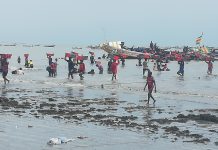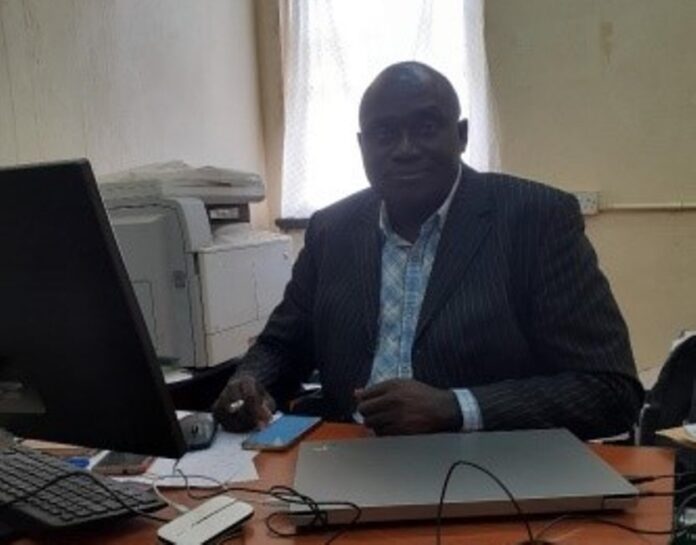With Madiba Singhateh
Climate change includes global warming driven by human emissions of greenhouse gases, and the resulting large-scale shifts in weather patterns. Though there have been previous periods of climatic change, since the mid-20th century the rate of human impact on Earth’s climate system and the global scale of that impact have been unprecedented. That human activity has caused climate change is not disputed by any scientific body of national or international standing. The largest driver has been the emission of greenhouse gases, of which more than 90% are carbon dioxide (CO 2) and methane.
Because land surfaces heat faster than ocean surfaces, deserts are expanding and heat waves and wildfires are getting more common.
Surface temperature rises also cause a rise in sea levels, thereby destroying many coastal settlements.
In this edition of the Environment Column, we will bring you an interview which this Columnist had with the Chief Forecast Officer at the Metrology Department on the extreme heat wave that the sub-region now experiences, current weather conditions, this year’s rainfall, etc.
Here are some of the excerpts of the interview:
Can you introduce yourself to our readers once again?
My name is Tijani Bojang. I am the Chief Forecaster at the Central Forecast Office under the Department of Water Resources. Our task is to monitor the weather and climate conditions and give information to Government and the general public as well as to other services such as Aircraft and Marine organisations.
Can you tell us about this year’s rainfall, and was your expectation fulfilled on the outcome of your predictions on this year’s season?
We have got significant amounts of rainfall this year and this was what we exactly predicted one or two months before the rains started. We have predicted that the sub-region will experience from normal to above normal rainfall and this has been manifested during this year’s rainy season which we also predict to officially end as at 31st October this year. So far, the cumulative rainfall amount has far exceeded above normal this year and we are yet to established the real statistics because we are waiting for 31st October to officially close, so that we provide the real statistics of how much rainfall has been recorded in 2020, and the percentage that makes it to exceed above normal. In the actual sense, this year’s rains have exceeded above normal.
Since this year’s rainfall has exceeded above normal, has this any determination to the warm weather condition we are in now?
Not in actual sense but we are experiencing a very hot situation at this time of the year. The climatology of this country is such that we transit from wet to dry periods. We were in the wet season which is about to end and we are gradually moving to the dry season. We normally experience very warm atmosphere during this period of transition from the wet to dry season every year. And we will continue to experience very warmer and hot situations during this period from mid-October to early November.
As we move from the dry season in May/June towards the rainy season, we equally experience very hot, warm and humid atmospheric conditions as well. This has nothing to do with rains above that are normal or below or above normal.
Right now, I have seen a weather alert on social media regarding the heat wave. But I do not know which country generated the alert. But that the forecast is normally for countries in Western Europe that are currently experiencing warm or hot strong winds from the South to the South Westerly. These winds originate from hot regions of the tropics and hence cause high temperatures over those places.
In the Gambia, maximum temperatures reach between 40-45 degrees Celsius and right now, the highest temperature at the moment is 36 degrees. We are yet to reach maximum temperatures in the country. But the transition period is always hot and that is what we are experiencing now.
Mr. Bojang, can you tell us how climate change relates to warmer atmospheric conditions that the country is experiencing now?
The cause of climate change is the emission of greenhouse gases such as carbon monoxide, carbon dioxide, methane and other renowned gases into the atmosphere.
Every tree needs carbon dioxide to survive. Therefore if we continue to cut down the trees, the carbon dioxide in the atmosphere becomes more abundant and this will mix with other emissions in the atmosphere that will enable the absorption of heat that cannot be retracted, to cause a rise in temperatures thereby heating ground and water surfaces.
Old cars contribute to climate change because they produce carbon monoxide. Gases such as Methane and others, are absorb and retracted back on the earth surface of the earth causing an inflation temperatures. If one looks some three decades back, one observes that temperatures have increased dramatically since then.
Now what are the mitigating factors that nations have to take, in order to reduce the impacts of climate change?
The Gambia has a National Climate Change Policy and a signatory to the convention of climate change protocols. What these policies advocating for are adaptation priorities particularly for poor countries like ours, because the impact is too hash on us.
It also has to do with mitigation plans by replacing the vegetation cover. Trees that have been cut down, need to be replaced. We should have control over the emission of the green houses in the country and should also look at the possibilities of eliminating these old cars that are producing carbon dioxide. Some are too old and emit lots of it.
Smart agriculture is another way of avoiding emission of gases such as methane, from rice cultivation. So these are some of the mitigation policies that Government is embarking upon. That is why you frequently hear tree planting exercises, which needs to be encouraged.
Should we expect a further rise in temperatures from 2021 onwards?
Well what we are we experiencing now is a gradual increase in national and global temperatures. We have seen this lately for the past years. This is because any vegetation cover that is cleared, takes years to recover and as the population increases, the demand for living gets higher. But with current mitigation trends, things can change in the near future if everyone participates, because the damage that has been done, is more than one can imagine. So is going to be hard to get all the lost vegetation cover within a five year period. Because of this, we will continue to experience increases in temperatures and what this does to Africa is that it reduces the quantity of rainfall and intensifies weather events like above normal rainfall with excessive downpours. Such events make precipitations of more than 100 millimeters of rain in a day.
Again when you experience drought condition, that year will be associated with low rainfall and this becomes so extreme that one hardly harvest from their farm. So this is how climate change impacts the people in the Sahel region including the Gambia.
What is your last word for the readers?
I thank you for the interview because we need weather and climate information to reach the people. This cannot be done without you the journalist disseminating that information to the people. It is important to acknowledge Media outlets such as yours where people can listen to information on the weather and other climate issues.





















